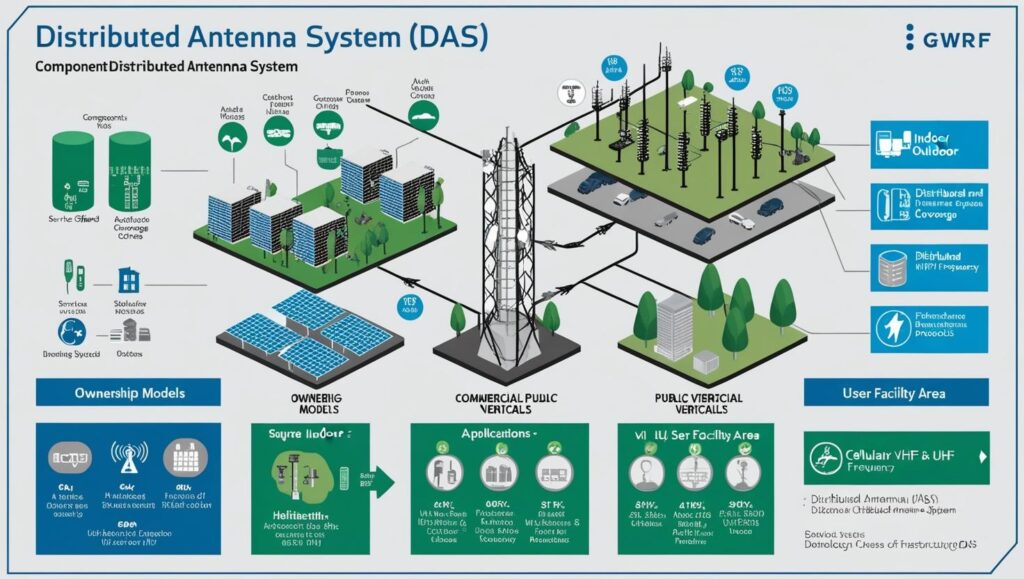As global connectivity continues to advance, the demand for reliable and high-speed wireless communication networks has never been greater. Distributed Antenna Systems (DAS) are playing a pivotal role in addressing the need for seamless connectivity, especially in urban spaces, large buildings, and densely populated areas. DAS technology is designed to improve cellular coverage and capacity by distributing the signal from a central source to various antennas located across a building or area. The result is enhanced signal quality, reduced interference, and, ultimately, better connectivity for users.
Explore how the DAS market is growing in response to the increasing demand for seamless connectivity, and the factors driving this transformation in wireless infrastructure.

The Need for Seamless Connectivity
With the proliferation of mobile devices and the continuous rise in data consumption, mobile network operators and businesses are under constant pressure to provide uninterrupted and high-quality wireless coverage. This is especially critical in environments like office buildings, shopping malls, stadiums, airports, hospitals, and even transportation systems, where large numbers of users need reliable service at all times.
The evolution of mobile networks—especially with the widespread adoption of 5G technology—has placed even more demand on existing infrastructures. 5G networks promise faster speeds, lower latency, and greater capacity. However, these advancements can only be realized when the underlying infrastructure, such as DAS, is equipped to handle the demands of next-generation networks.
In response, many businesses, municipalities, and network operators are investing in DAS to ensure high-quality service in areas where traditional cellular towers cannot provide adequate coverage.
What are Distributed Antenna Systems (DAS)?
A Distributed Antenna System (DAS) is a network of antennas that work together to improve the coverage and capacity of wireless communication systems. DAS helps overcome common challenges associated with large buildings or areas, such as poor signal strength, signal interference, and network congestion. By placing antennas in strategic locations throughout a building or campus, DAS ensures more reliable connectivity, particularly in areas that experience heavy traffic or where traditional infrastructure is insufficient.
DAS typically comprises three components:
Headend System – The central unit that connects to the primary wireless network and distributes signals.
Antenna System – A series of antennas placed in various locations throughout the coverage area to improve reception and transmission.
Fiber Optic Cable – Used to connect the antennas to the headend system, ensuring high-speed data transmission across the network.
As 5G and other advanced wireless technologies continue to emerge, DAS plays an increasingly critical role in expanding and optimizing network coverage in commercial, industrial, and public spaces.
Download PDF Brochure @ https://www.marketsandmarkets.com/pdfdownloadNew.asp?id=25689918

Growth Drivers in the DAS Market
1. Increasing Demand for High-Speed Data and Better Connectivity
The explosive growth in internet-enabled devices, IoT devices, and streaming services is pushing the demand for faster, more reliable wireless connectivity. With users demanding high-speed data for activities such as video conferencing, remote working, and online gaming, DAS provides a solution by enhancing network capacity and ensuring smooth data delivery. As mobile data traffic continues to rise, businesses and municipalities are turning to DAS solutions to accommodate this demand, particularly in densely populated areas or large buildings with high foot traffic.
2. 5G Rollout Driving Market Expansion
The transition to 5G networks is one of the primary factors driving growth in the DAS market. 5G promises a leap in wireless capabilities, with data speeds expected to be up to 100 times faster than current 4G networks. This presents significant challenges for traditional cellular infrastructure, particularly in urban environments or buildings with dense materials that interfere with signals.
DAS is a key enabler of 5G rollout, as it allows mobile operators to extend 5G coverage indoors, in large venues, and in areas where signal attenuation is common. The need to ensure a seamless 5G experience for consumers in places like shopping malls, airports, and large office buildings is one of the major drivers behind the expansion of DAS installations.
3. Increased Adoption in Smart Buildings and Smart Cities
The rise of smart buildings and smart cities is another factor propelling the DAS market forward. Smart buildings rely heavily on seamless connectivity to support IoT devices, security systems, and communication tools. As more commercial real estate owners and city planners integrate smart technologies into their infrastructures, the need for effective, high-capacity wireless networks has increased. DAS offers a reliable solution to meet these connectivity needs while also ensuring that wireless systems operate efficiently across a variety of platforms and devices.
For example, in large office complexes or multi-use facilities, DAS can provide wireless connectivity across a range of environments, ensuring that employees, tenants, and visitors have access to high-speed networks regardless of their location in the building. This contributes to improved productivity, safety, and communication in the workplace.
4. Expanding Demand in High-Traffic Venues
Large venues such as stadiums, concert halls, and convention centers require robust wireless infrastructure to accommodate thousands of users simultaneously. In these environments, traditional cellular networks often struggle to maintain service quality due to congestion and interference. Distributed Antenna Systems can provide the necessary network capacity and coverage to meet the demands of large crowds by optimizing signal distribution across multiple antennas.
The growing popularity of live-streaming events, mobile payments, and social media usage in high-traffic venues has made DAS a crucial component in ensuring that visitors and participants have reliable access to high-speed connectivity.
5. Improved ROI for Enterprises and Operators
From a business perspective, investing in DAS equipment and services can offer a solid return on investment (ROI) in the long run. With the ability to enhance service reliability and support high-bandwidth applications, DAS helps businesses improve customer satisfaction and ensure a competitive edge in the market. Additionally, the lower cost of maintenance compared to traditional cellular towers, along with the scalability of DAS solutions, provides a cost-effective way for enterprises to improve wireless coverage without significant infrastructure changes.
Challenges and Opportunities
While the DAS industry presents significant growth opportunities, it also faces certain challenges. High installation costs, the complexity of integrating new technologies, and the need for constant maintenance and upgrades are some of the hurdles that companies need to navigate. However, with the growing demand for seamless connectivity, these challenges are likely to spur innovation in DAS technology and open up new business opportunities.
As mobile operators and enterprises continue to explore new ways to optimize their networks, DAS will play an increasingly important role in ensuring high-quality, uninterrupted service in both urban and remote locations.
The growth of the Distributed Antenna Systems (DAS) market is fundamentally tied to the increasing demand for seamless and high-speed connectivity across various sectors. As the world transitions to 5G and the need for reliable, high-capacity networks continues to rise, DAS technology will remain a cornerstone of modern telecommunications infrastructure. With applications in healthcare, smart buildings, high-traffic venues, and more, the future of DAS is promising, offering smarter, more efficient ways to meet the evolving connectivity needs of businesses and consumers alike.
About MarketsandMarkets™
MarketsandMarkets™ is a blue ocean alternative in growth consulting and program management, leveraging a man-machine offering to drive supernormal growth for progressive organizations in the B2B space. We have the widest lens on emerging technologies, making us proficient in co-creating supernormal growth for clients.
The B2B economy is witnessing the emergence of $25 trillion of new revenue streams that are substituting existing revenue streams in this decade alone. We work with clients on growth programs, helping them monetize this $25 trillion opportunity through our service lines – TAM Expansion, Go-to-Market (GTM) Strategy to Execution, Market Share Gain, Account Enablement, and Thought Leadership Marketing.
Built on the ’GIVE Growth’ principle, we work with several Forbes Global 2000 B2B companies – helping them stay relevant in a disruptive ecosystem. Our insights and strategies are molded by our industry experts, cutting-edge AI-powered Market Intelligence Cloud, and years of research. The KnowledgeStore™ (our Market Intelligence Cloud) integrates our research, facilitates an analysis of interconnections through a set of applications, helping clients look at the entire ecosystem and understand the revenue shifts happening in their industry.
To find out more, visit www.MarketsandMarkets™.com or follow us on Twitter, LinkedIn and Facebook.
Contact:
Mr. Rohan Salgarkar
MarketsandMarkets™ INC.
1615 South Congress Ave.
Suite 103
Delray Beach, FL 33445
USA : 1-888-600-6441